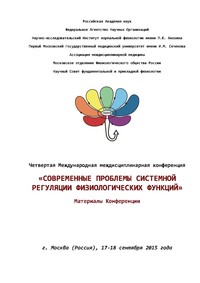ОСОБЕННОСТИ ПСИХОФИЗИОЛОГИЧЕСКОГО РАЗВИТИЯ ДЕТЕЙ 6-7 ЛЕТ, ИМЕЮЩИХ ПРИЗНАКИ ДЕФИЦИТА ВНИМАНИЯ
Бесплатно
Основная коллекция

Издательство:
НИИ ноpмальной физиологии им. П.К. Анохина
Год издания: 2015
Кол-во страниц: 5
Дополнительно
Скопировать запись
Фрагмент текстового слоя документа размещен для индексирующих роботов.
Для полноценной работы с документом, пожалуйста, перейдите в
ридер.
In the control group ball release occurred prior to take-off, i.e. the person under test first released the ball, and then jumped. This specific feature of the control group was indicative of action delay and mismatch prior to jumping, the jump was a dominant, and all the control was directed thereto. At the second stage of the research, the dynamics of changes in anatomic angles was analyzed in members of both groups. In the basic group at take-off commencement the pelvis-shoulder-head angle, which was indicative of the body uprightness 15012°, then at the moment of ball release the smooth bending to 1208° occurred, followed by the stretching at touchdown phase. In the control group value of angle 12014° (р<0,05)° during the jump. While low jumping, members of the control group bent hard in thoracic spine area. It is noteworthy that the representatives of the control group were simulating the ball release action in the unsupported position even after ball release completion, as evidenced by the angle dynamics of the elbow joint of the shooting arm. In the athletes of the basic group the pelvis shoulder-elbow angle was 806° at the jump start. Then the angle smoothly rose to 13010°(р<0,05), after that the shot was made, and the angle remained unchanged till the touchdown moment. In the representatives of the control group this angle was already 13012° prior to the jump, and its remained practically unchanged till the touchdown moment. Conclusion: Obtained results testify that structural readjustments in a motion system when training on the accuracy of shots provide first of all adaptation to an unsupported position, motions coordination, and turn body hanging-ups in the air to a technical skill. In the absence of skill understanding the shooting the ball from the place and the high jumping, are not capable of implementation of that skills in an unsupported position. Literature: 1. Kazennikov O.V. Hum. Physiol. 2011. No 5. P.108-112 2. Kapilevich L.V. Theor. and Pract. Physic. Cult. 2012. No.7. P.45 48. 3. Koshelskaja E.V. Bull. Experim. Biol. Med. 2012. No. 2. P.235-237. 4. Koshelskaja E.V. Theor. and Pract. Physic. Cult. 2014. No.12. P.47-49. DOI:10.12737/12392 ОСОБЕННОСТИ ПСИХОФИЗИОЛОГИЧЕСКОГО РАЗВИТИЯ ДЕТЕЙ 6-7 ЛЕТ, ИМЕЮЩИХ ПРИЗНАКИ ДЕФИЦИТА ВНИМАНИЯ Н.П. Кривошеина, Н.Н. Кошко, И.А. Свиридова, Э.М. Казин, А.И. Фёдоров ФГБУ ВПО Кемеровский государственный университет ГОО «Кузбасский РЦППМС» Аннотация: В работе рассматриваются особенности психофизиологического развития детей старшего дошкольного возраста,

